Berkeley’s falcon family of five: Annie, Lou and three fluffy chicks
But it's a deadly time for birds. Avian influenza rages; a Cal Falcons Q&A about it is April 27.
April 13, 2023
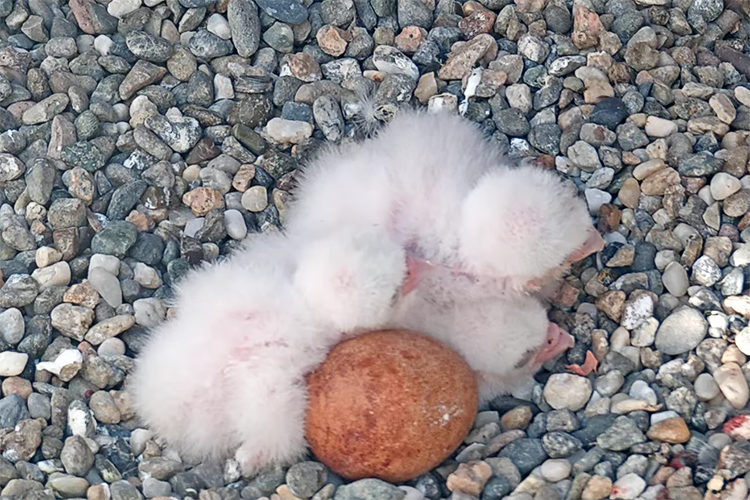
The three chicks that hatched this week at UC Berkeley lean against each other and the unopened egg in their nest box on the Campanile. (Image by Cal Falcons)
It’s finally spring at UC Berkeley: Three downy peregrine falcon chicks have emerged from their eggshells in a nest atop the Campanile. The hatchlings arrived April 10, 11 and 13; a fourth egg laid by falcon mother Annie hasn’t opened. So far, 18 chicks have hatched over the years on the bell tower, which Annie claimed as her home in late 2016 with then-mate Grinnell.
Mary Malec, a raptor expert with Cal Falcons, said Friday that she had waited a few days to declare the remaining egg not viable, but that “it’s time. It’s unlikely the egg will hatch.”
The recent chilly, rainy weather may help explain why on Thursday the third egg opened outside of the usual time frame for falcon eggs to hatch in this setting, said Sean Peterson, an environmental biologist with Cal Falcons. “A cold spring like we had this year can slow embryo growth, resulting in a longer hatch window.”
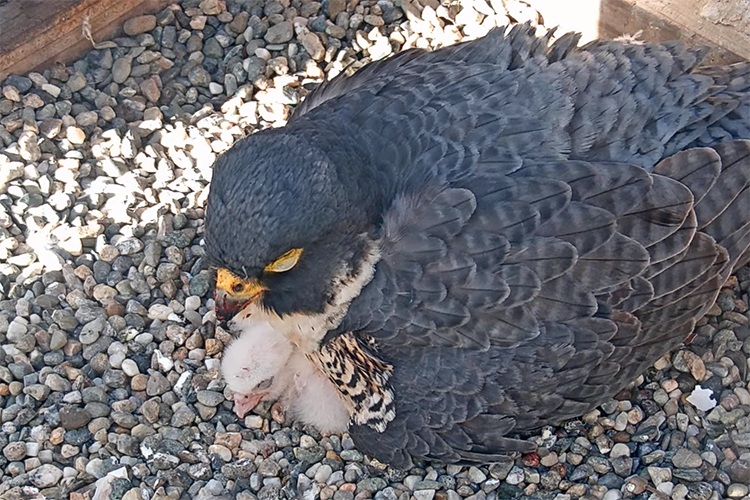
Annie keeps her hatchlings warm on Thursday, April 13, the day the third and final chick of 2023 came out of its shell. (Image by Cal Falcons)
Each year, Annie’s eggs don’t all hatch, said Peterson. “We simply don’t know why,” he said. “There are a number of reasons eggs fail to hatch — everything from being unfertilized to developmental problems with the embryo.” He added that the approximately nine-year-old raptor, who has had a new mate, Lou, since late 2022, “has been a highly successful falcon, in terms of reproductive success.”
This week, Annie’s family expanded beyond the campus, too. Larry, or Lawrencium, who hatched at Berkeley in 2018, produced four chicks of her own on Alcatraz Island, where she’s nested for several years. Seven or eight of her chicks from previous years have been sighted after learning to fly, said Malec. Larry’s had three broods since 2020.
Yesterday, the National Park Service released a photo of Larry’s nest, and Annie’s latest grandchicks.

Lou brings dinner to the hatchlings. They begin eating small pieces of meat about 12 hours after hatching. (Image by Cal Falcons)
A worldwide tragedy: Avian influenza
But these are precarious times for birds, as avian influenza, or bird flu, rages among the world’s wild and domestic bird populations. Recently, it claimed the life of Shasta, a female falcon nesting on San Jose City Hall. She was the mate of Sequoia, one of Annie’s three 2020 offspring. Sequoia has been missing ever since. Shasta was about to lay the pair’s first eggs.
“Viewers of the camera (on San Jose City Hall) saw her collapse at the nest box,” said Peterson. “She was later picked up and taken to a rehab facility, where she died. Because of her symptoms and the great concern with this disease, she was tested for avian flu, and it came back positive.”
Added Malec, “We’re pretty sure that’s why we haven’t seen Seqouia.”
Larry and Sequoia have been the only two grown falcon offspring of Annie and Grinnell, who was killed last year, whose whereabouts were known. Two of the pair’s other descendants — Lux and Lindsay — died very young, one while fledging, the other shortly after she’d learned to fly.
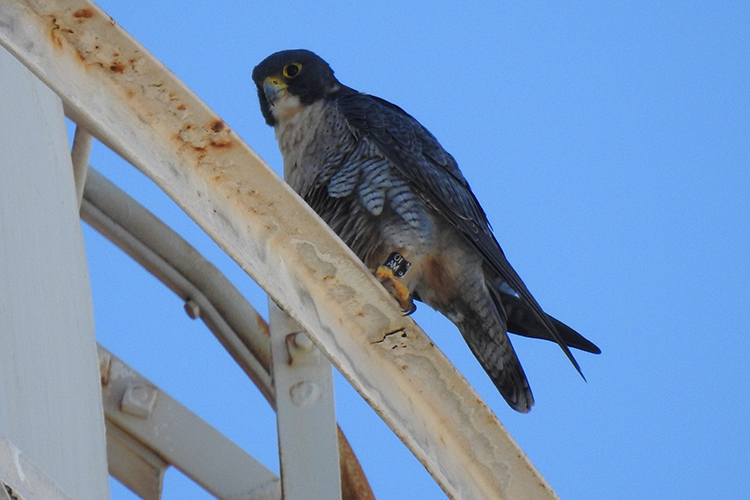
This photo of Sequoia, one of Annie and Grinnell’s 2020 offspring, was taken in early 2022. when he was seen on a water tower in Santa Clara. (Photo by Craig Ow)
Avian influenza also is striking another raptor, one that’s endangered. The U.S. Fish and Wildlife Service two days ago reported that free-flying California condors are falling ill in Arizona and dying from the disease at an alarming rate.
“It’s hitting raptors incredibly hard,” said Peterson, “and has a near-100% fatality rate.”
He added that it also may have killed Alden, Annie’s second mate, who disappeared last November.
“There are a couple of things that may support the hypothesis that Alden contracted the flu,” said Peterson. Alden disappeared during a spike in bird flu in the Bay Area, he said, and he almost exclusively hunted shorebirds, which act as a carrier population for the disease.
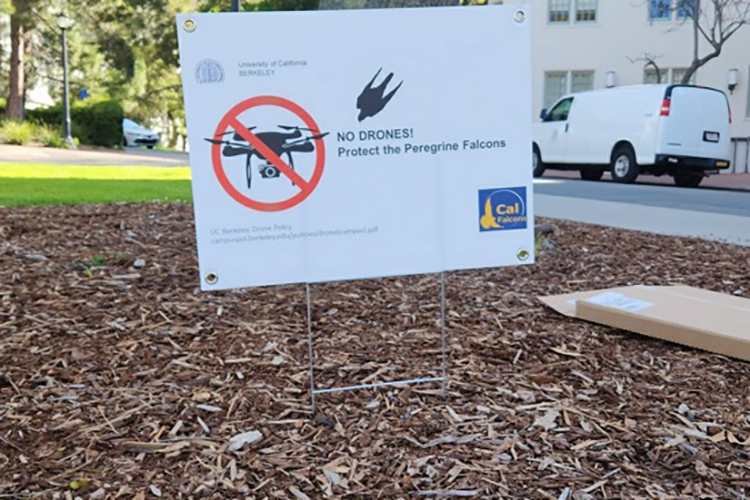
Not just avian influenza, but drones are a threat to wild birds. Warning signs went up again today near the Campanile, where drones have led to close calls for Berkeley’s falcons. (Image by Mary Malec)
“Annie, on the other hand, hunts mostly pigeons, which aren’t as susceptible to spreading the disease,” he added.
Peterson and biologist Lynn Schofield will host a virtual Q&A about avian influenza on Thursday, April 27, at noon with Dr. Victoria Hall, executive director of the Minnesota Raptor Center. The center is a globally renowned veterinary organization specializing in the health of birds of prey.
“Fingers crossed” for Berkeley’s beloved falcons, said Malec.
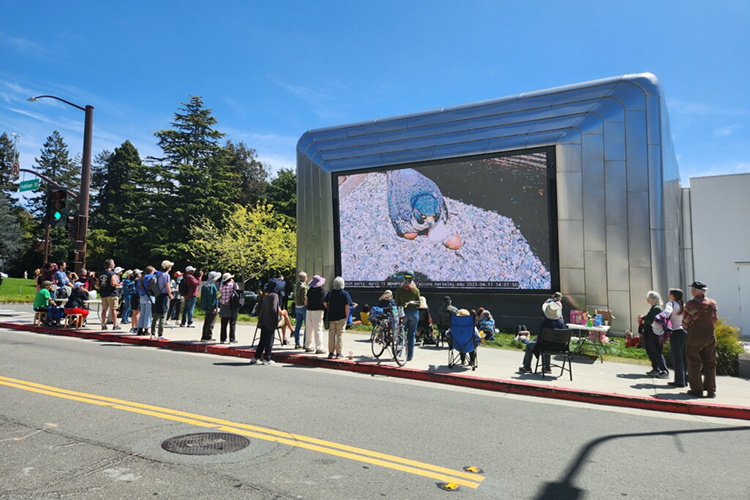
On April 11, a Hatch Day event outside the Berkeley Art Museum and Film Archive drew as many as 800 people between 9 a.m. and 7 p.m. The hatching was shown live on the big outdoor screen that faces Addison Street. (Image by BAMPFA)
Celebrating, explaining the hatching
The campus’s falcons have an enormous fan base that stretches around the globe, and this week — on Cal Falcons’ social media, in a virtual Q&A with Peterson and Schofield, in the media and on campus — excitement was palpable for the arrival of this year’s chicks.
On Tuesday, between 9 a.m. and 7 p.m., as many as 800 people stopped by the Berkeley Art Museum and Film Archive (BAMPFA), where the hatching was displayed live on a giant outdoor screen and raptor experts answered the public’s questions. The Cal Falcons Q&A drew an audience of 2,200 people, and another 6,500 people watched the event later in the day.

Chick No. 3 emerges from its shell. (Image by Cal Falcons)
Earlier this week, after emerging from their eggs looking wet, pink and featherless, the newborns — having grown down feathers before hatching — soon dried off and sported white fluff. They’re now recovering from hatching and continuing to grow by napping and occasionally eating, said Peterson.
Lou, who became Annie’s new mate late November 2022, will be the primary hunter for about three weeks, then Annie will resume hunting again.
“Annie will do the lion’s share of caring for the chicks for the first week. She probably will only rarely leave their side,” he said. But Lou will help incubate the chicks and give Annie a break now and then, as he has since the eggs were laid.
Peterson added that Annie “will fiercely defend her chicks and her nest if there’s any danger and will often care for the unviable eggs for many days after the chicks hatch.”
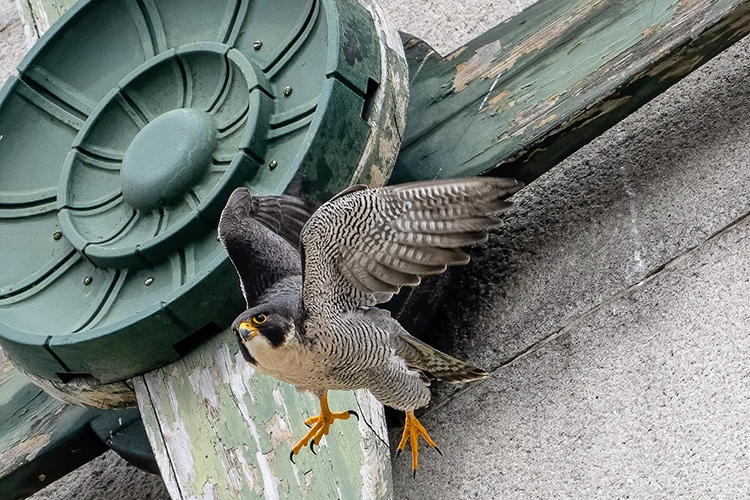
Lou will do most of the hunting for about three weeks while Annie cares for the hatchlings in the nest. (Image by Bridget Ahern)
The chicks’ first flights are expected around May 21 for any male chicks and around May 23 for any female chicks. The two chicks’ sexes will be determined when they’re banded at 24-25 days old. Cal Falcons plans to hold another virtual Q&A session at that point.
Around 50% of peregrine falcons that learn to fly and leave the nest survive their first year of life.
“Given those numbers,” said Peterson, “we would expect another six or so of Annie’s chicks are out there somewhere, making their way through the world.”